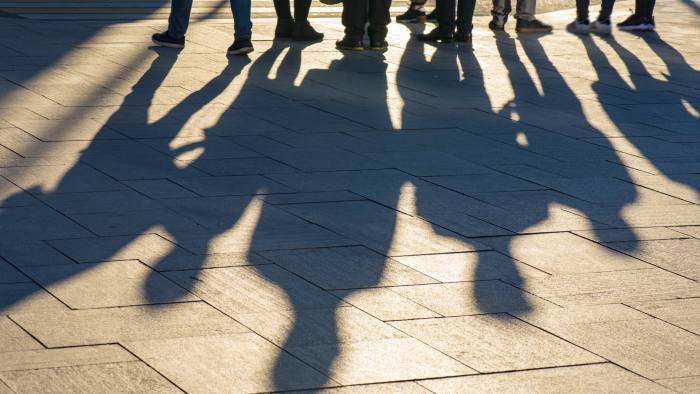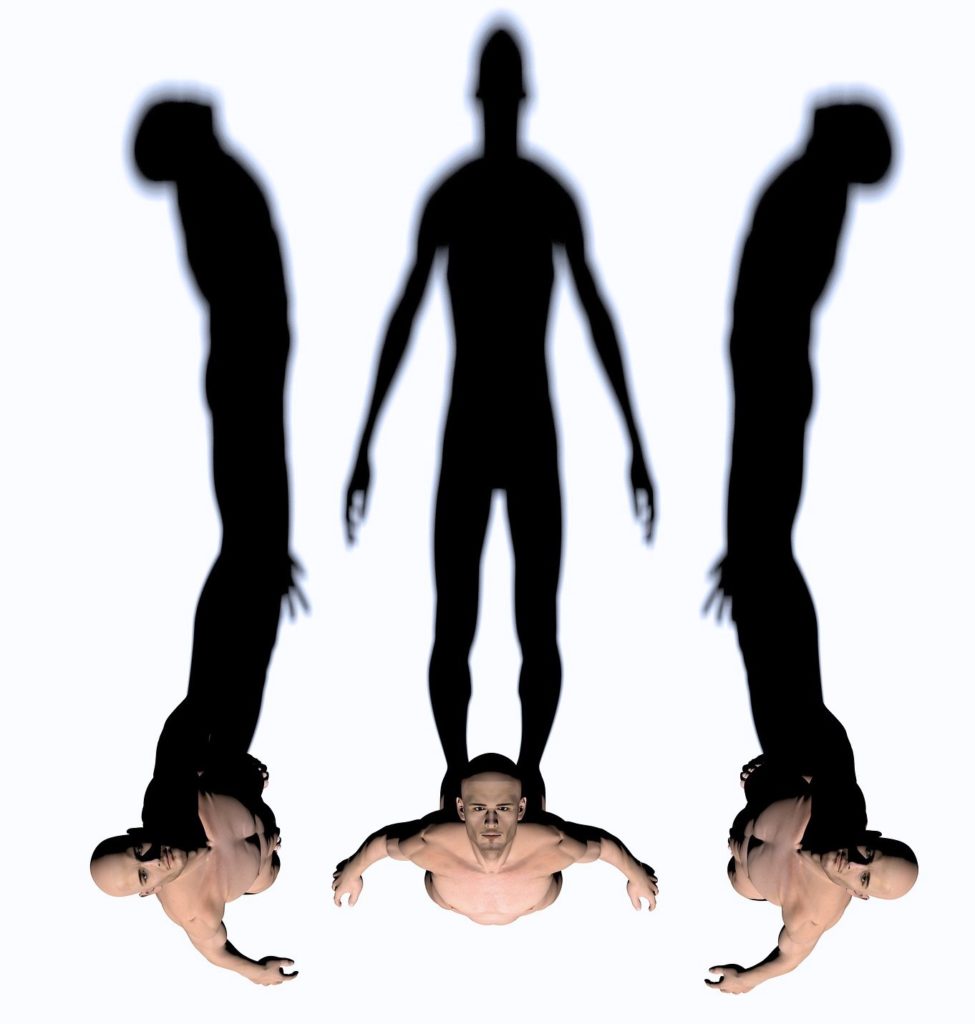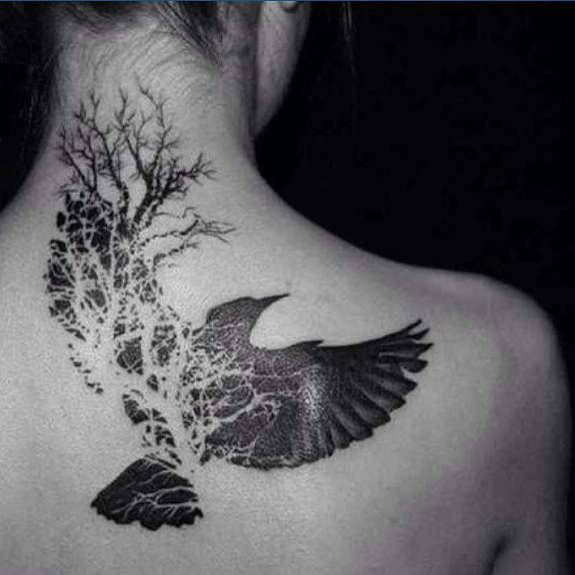
As someone who has tinkered with the title and sub-title of his book repeatedly—the “working titles” are still Work Life Reward: The Call & Response of a Good Life At Work—I love it when any other author (or the “book title folks” at the publisher) come up with “the right one.”
Owning Your Own Shadow, a 1991 book by Robert A. Johnson, is such a title, in part because “shadow” includes the good and not-so-good aspects of this unacknowledged part of you. In additon to the personality traits or obsessions that you need to take (perhaps) reluctant responsibility for, your shadow also embraces qualities that would or could be transformational if you hadn’t buried them in a bid to conform to the culture’s (your family’s, your community’s and the overall society’s) expectations.
That is, the rangy, ragged, unorthodox, magnificent but largely disowned parts that fill people out and can truly make them whole.
That’s what I want to talk about today—particularly, the “golden, often heroic” face of our shadows—and I borrowed Johnson’s title, along with his notion of ownership, to begin the discussion.
Of course, a quote from the always-quotable Oscar Wilde could also have started out today’s post. In The Critic As Artist, Wilde said: “Man is least himself when he talks in his own person. Give him a mask and he’ll tell you the truth.” That characterization still begs the question of whether “Wilde’s truth behind the mask” or “Johnson’s unowned shadow” are for the better or for the worse—and their concepts clearly include both darkness and light—but again, it’s the light in the shadow (or that’s hidden by a mask) that interests me most.
Why do we persist in disowning the quirkiest, oddest, most singular, imaginative, creative, “golden” and “heroic” parts of ourselves, when we can (and should) be relying upon our shadows to make our greatest contributions and deliver our deepest satisfactions?

According to Johnson (as well as Carl Jung, whose groundbreaking insights he relies upon), the parts of us that seem lost in shadow are the parts we have banished or repressed because the culture finds them socially unacceptable, contrary to established norms, too-at-odds with its overall “comfort zone” to tolerate. So we try to banish these tendencies and drives, refusing to acknowledge any ownership of them at all. But it’s a fool’s errand because every single thing that we do produces a shadow, and it belongs to us whether we accept it or not.
For example, every hardworking and productive person creates a shadow that wants to goof-off and waste time, but at the same time, steadfastly refuses to acknowledge her shadowy motivations (as if they were a slippery slope). Or a person may assume that others are more capable than he is, burying in his shadow the talents that are inside of him too. For him, a shadow of his greatness is always there, but every time he looks at it somebody else seems to be wearing it.
Instead of owning our shadows, Johnson argues that each of us distances ourselves from it by “projecting” our shadow onto someone or something else so “we do not have to take responsibility for it” by assimilating this part of our character into the self that we recognize and acknowledge. He continues:
Today, whole businesses are devoted to containing our shadows for us. The movie industry, fashion designs, and novels provide us with easy places to invest our shadow. Newspapers offer us a daily allotment of disasters, crimes, and horrors to feed our shadow nature outwardly when it should be incorporated into each of us as an integral part of his [or her] own personality. We are left as less than whole personalities when we invest our own darkness [and our other shadowy parts] into something outside ourselves. Projection is always easier than assimilation.
Stories about true crime, superheroes, political manipulation, sexual predators, militia groups, (name your non-conformists) as well as perfect athletes and actors, and “god-like” entrepreneurs (like Steve Jobs or Elon Musk) alos invite us to project our dark or “golden and heroic” shadows upon them instead of owning them ourselves.
Jung warned and Johnson echoes that banishing our dark shadows is easier for most people than liberating their golden ones. We often flat-out refuse to see the hero inside of us, resisting our potential because we might not be up to realizing it. On the other hand, projecting our golden shadows unto others is commonplace. It’s easier to worship from afar than to become (or to own) a lesser version of our loftiest ideals. “Some of the pure gold of our personality,” writes Johnson, “is relegated to the shadow because it can find no place in…culture.” Neither we nor our families, schools or communities seem to be able to welcome or accommodate our heroic sides, or so we insist upon thinking.
It takes a conscious intent—a push against personal and cultural resistance—to reconcile with our golden shadow-selves. When we push back, the effort can be transformational because assimilation of the shadow unlocks reserves of energy, power and creativity that have been repressed or otherwise disowned. Assimilation also establishes an internal balance between how we live and work in plain view and the shadows we cast (but insist on ignoring) while engaged in these same activities. Johnson speaks of finding an internal balance between “heaven” and “hell,” but it is also the balance between “the lion” and “the mouse” in each of us. He writes:
The shadow also contains a good deal of energy, and it is the cornerstone of our vitality. A very cultured individual with an equally strong shadow has a great deal of personal power. William Blake spoke about the need to reconcile these two parts of the self. He said we should go to heaven for form and to hell for energy—and marry the two. When we can face our inner heaven and our inner hell, this is the highest form of creativity.
Late fall and winter are particularly good times of year to acknowledge, explore and begin to assimilate a side of ourselves that will make us more energized, powerful and creative in the spring and summer, once we gather the courage and sense of adventure that we’ll need so we can face it.
To dig deeper, you can listen to a short lecture on YouTube in which Johnson elaborates upon his observations in Owning Your Own Shadow. I also recommend reading this short but provocative book.

A chance to pencil in the shadow.
I suspect I was drawn to the shadows this week because it was Halloween last weekend.
Wearing masks briefly suspends real world rules so “a human can become a god, an ordinary citizen can become a king, a man can become a woman” in a form of shadow play that anthropologists call “rituals of inversion.”
Ritual celebrations like this give everyone a break before returning to conformity and more sobering realities. So every year, Halloween’s revelers are pulled back into the real world by All Souls Day. and the celebrants of Carnival or Fat Tuesday (at the other end of this calendar) by the long weeks of Lent. It’s also not a coincidence that days “where everything is turned upside down and the shadows can come out to play” occur during seasonal transitions, either as summer starts fading into winter in the fall, or as winter starts fading back into summer during the spring. They’re like pivot points where everything is up for grabs. With all of that in mind, I found it interesting to learn this week that the first Halloween parade in the U.S. took place not in New York City, San Francisco or New Orleans but in Hiawatha Kansas, in 1914–or in small town America, a place that may be a great deal more adventurous than many of us expect.
Because people everywhere need to get away like this—it’s replenishing to spend time behind Wilde’s mask—doing so makes it’s easier to come back to the same old thing tomorrow.
Perhaps because of Halloween, along with a tingling sensation that our culture itself is unsettled and struggling to decide where to land, but every time I turned on the radio or listened to a podcast this week, the subject seemed to be about owning your own shadow for more than one or two days a year—a more permanent kind of assimilation or reconciliation with our shadow selves. I found a couple of these journeys into the shadow-lands and back again particularly captivating.
For as long as I can remember there have been Renaissance Faires. I couldn’t imagine going and didn’t understand why any one else would want to until I learned more about them this week. At their best, they are vehicles that seem to enable their singular cast of players, artisans and dedicated historians to bask in the glow of their golden shadows. Children of the counter-culture Sixties, Renaissance Faires aimed to create a kind of alternate reality with “real” food appropriate to the time, hand-made as opposed to mass-produced crafts, Carnival-esque entertainments, champions competing in jousting and other games of skill or chance, along with the pageantry, music and camaraderie of others who’d also come to explore a different part of themselves. The transporting and reconciling aspects of these festivals became apparent in several of the participants’ stories on a podcast this week.
Because you can make a kind of living moving from one Renaissance Faire to another—one is staged somewhere in the U.S. at most times of year—one man spoke about the joys of playing his particular character over and over: a champion who had moved from serfdom to Faire-ground hero on the basis of his skills at one of the regularly staged contests. (Nearly every contestant seems to have a detailed backstory as well as knowing fans who follow him or her to multiple venues). This guy plays his hero ten months of every year, returning to Georgia for two months in the summer where there always seems to be a job waiting for him at a local pizza parlor.
For his part, the son of the founders of the original Faire (a highly articulate fellow named Kevin Patterson) spoke about his continuing efforts to “curate” the festivals that he’s involved in for quality and historical accuracy because he (along with the attendees) care so much about both of them. A public radio reporter whom I listen to regularly dialed in to talk about a storytelling role that he’s played at a Faire each year for much of his adult life. All of these people leave the so-called real world on an enthusiasticly regular basis to embrace a golden shadow that lives in each of them and needs inhabiting. You can hear more of their stories in the hour-long episode of 1A called “Fare Thee Well: the Timeless Endurance of Renaissance Faires” by following this link.

In jarring contrast was a local talk show about the healing power of tattoos that people have gotten in response to personal trauma. Some women (in particular) have managed to find a kind of reconciliation with darker shadows that a tattoo also manages to move towards a more golden and heroic light after they’ve experienced rape, life in a combat zone, or suffered the death of a child.
For an often harrowing hour, guests spoke about how the permanency and visibility of their tattoos, together with the pain of getting them, had enabled them to not only grapple with the darkness within them but also to make their way to a better and more full-bodied story as they touched, looked at, or talked with others about the meaningful images they had chosen to brand themselves with. The discussion was around The Tattoo Monologues: Indelible Marks on the Body and Soul by Donna Torrisi, a nurse practitioner who treats victims of trauma and was a guest on the show. Along with Torrisi and several women sharing their experiences, the conversation included a trauma therapist and a professor who explores the range of therapeutic approaches to traumatic events.
Some of the women had gotten tattoos of butterflies or flowers for a parent or child who’d been lost so that out of the pain something permanent and beautiful was left behind. Others saw in the process of selecting the image, deciding where it would go on their bodies, working with the tattoo artist to realize the image, and even the pain of the emblazoning as ways to move from helplessness to control of the traumatic experience and how it would be remembered. Still others felt that their tattoos allowed them to reverse “the disassociation” they had felt during their trauma and replace it with something tangible that they could see and touch, that belonged to them, and that they owned. Finally, one woman simply said that her tattoo allowed her to speak about her trauma without words; the canvas of her skin becoming an embodiment of what she had experienced in the way that she wanted to express it.
After grappling with darkness, each of these women seemed to find the silver lining in their particular cloud, the gold in their particular shadow.
If you are interested in the full conversation, you can access it here (searching “tattoo monologues.”)
At this already unsettled pivot point between summer and winter (and maybe in our culture itself), I think it’s a particularly good time to push back against everyone else’s expectations and unlock both the energy and creativity that always lies in wait in a disowned shadow.
This post was adapted from my November 7, 2021 newsletter. Newsletters are delivered to subscribers’ in-boxes every Sunday morning and occasionally I post the content from one of them here. You can subscribe by leaving your email address in the column to the right.
Wonderful article! The recent docu-series Ren Faire is a great example of the shadow magician.
Thanks for getting back and for your recommendation Marc.